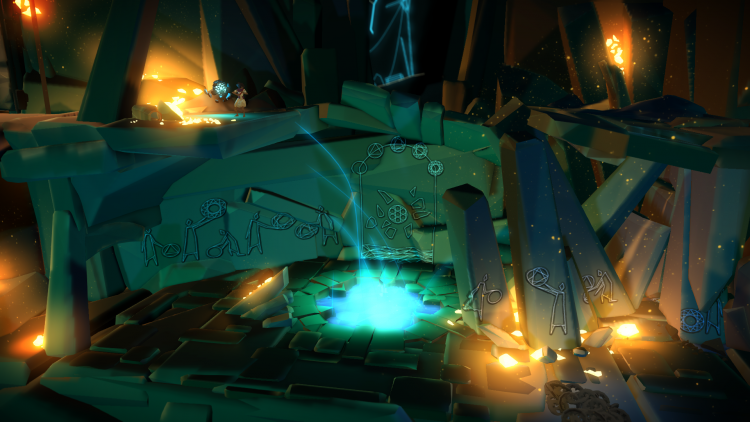The protagonist’s companion is a staple of many well-loved works. Animals, big and small, are often featured in this role, but sentient humanoids may fill it as well. Whatever the case, these characters are vital to the success of the protagonist, and remain their stalwart support throughout the story. This means that in video games, these companions often become the player’s best friend. When immersion is the goal of a game, companion characters can make or break it.
Golem is a puzzle-adventure game made by Longbow Games. You play as a human, whose companion is a softly-glowing blue orb, floating amidst chunks of stone. The orb can’t do much, but it’s necessary for unlocking doors to progress, so you haul it around anyway.
In this beginning phase, necessity is the only thing that ties you to your companion. The orb has no lines. The orb has very simple movements. The orb can’t move on its own. It simply exists, and that’s… basically all it does. It would be easy to judge this game by the first five seconds. Pushing-around-a-ball simulator? You could do that in real life. Why bother with this game? Golem answers this question soon enough: Because sometimes, the wait is worth it.
Cue: the golem. The game is named after this creature. Unsurprisingly, this means it’s essential to gameplay. As soon as you push your orb into the blue-glowing pool, it begins to form two wobbly legs. No longer do you have to push the orb around. It can push itself, and it listens to your commands to “follow” and “stay.” A relief, sure – but there’s more to it.
With this advancement, the golem has also begun to show its personality. Where previously, players saw only a simple, floating ball, they can now see their golem for the creature it really is. Its idle animations include stretching its legs and tapping itself on the “head,” like one might hit a machine to kick it into gear. Its controls are simple, and its movements rudimentary, but there is no doubt that the golem is now very much alive, and is becoming its own character before the player’s eyes.
Progression through the game includes several more changes to the shape of the golem. First, it has two legs, then four, plus a tail. Then two of those legs become hands, and it takes on an almost ape-like appearance, caring for the protagonist the same way she cared for it. Players see their bond progress through the game, and watch as their skills as a team improves too.
But the most impressive part about all of this is that it’s done completely without words. Dialogue is often an essential part of conveying a character’s thoughts and feelings, and this game has none. Instead, it communicates all of that and more through body language and motion, fluidly telling the tale of a brave adventurer and her golem as they traverse ancient ruins. It’s hard to imagine the work and precision that went into animating each movement, specifically to invoke the feelings of endearment that the golem creates. Without ever saying a word, this little creature can tap-dance its way into anyone’s heart, so long as they’re willing to give it a chance.
This kind of character design is often lost in favor of flashy graphics and bigger weapons. Although these things have a place in games, good character design has a place too, and it’s refreshing to see a game that hasn’t forgotten this fact.
If you’re interested in trying Golem for yourself, you can find it on GOG, here, and on Steam. For more information, check out the website for Longbow Games.



